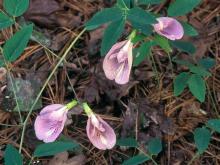Wildflowers, Grasses and Other Nonwoody Plants
Media

Species Types
Scientific Name
Ludwigia peploides
Description
Water primrose is a common shoreline plant with bright yellow flowers and long, trailing stems. It grows in dense mats in the shallow areas of ponds, lakes, and streams.
Media

Species Types
Scientific Name
Dioscorea oppositifolia (sometimes called D. batatas)
Description
Similar to kudzu, Chinese yam is an aggressive vine that overtakes nearly everything within reach that stands still long enough! Learn more about this invasive plant — and please don’t plant it!
Media

Species Types
Scientific Name
Potamogeton spp.
Description
Pondweeds are rooted aquatic plants with underwater leaves on long, flexible, jointed stems. Some have floating leaves, too, that are differently shaped. Missouri has about 10 species in the pondweed genus.
Media

Species Types
Scientific Name
Commelina communis
Description
The flowers of dayflower are truly blue, and they have only two conspicuous petals. A fast-growing, sprawling, but shallow-rooted weed, this introduced species commonly annoys gardeners.
Media

Species Types
Scientific Name
Ipomoea pandurata
Description
Wild potato vine is related to the sweet potatoes we buy at grocery stores. This native vine is also related to the morning glories that decorate trellises and to the bindweed that plagues gardeners and farmers.
Media

Species Types
Scientific Name
Calystegia sepium (also Convolvulus sepium)
Description
Instantly recognizable as a type of morning glory, hedge bindweed is common in disturbed habitats and can be a serious agricultural weed, but it is not as problematic as its relative field bindweed.
Media

Species Types
Scientific Name
Clitoria mariana
Description
Butterfly pea is a low, shrubby, or twining perennial in the pea family, with showy, butterfly-like flowers. The leaves are compound with three leaflets. This species grows in the southern parts of Missouri, in acid soils.
Media

Species Types
Scientific Name
Lathyrus latifolius
Description
Everlasting pea is an old-fashioned garden plant your grandma might have grown on a fence. Native to the Old World, it often persists at old homesites.
Media

Species Types
Scientific Name
Mimosa quadrivalvis (also Schrankia nuttallii)
Description
Sensitive briar is a dainty-looking legume with delicate, twice-compound leaves and flower heads resembling magenta pom-poms. The long, tough stems are covered with tiny thorns that snag your feet as you walk.
Media

Species Types
Scientific Name
Subfamily Asclepiadoideae
Description
Milkweeds are a group of plants that used to have their very own family. Now part of the dogbane family, they’re still a pretty distinctive group.
See Also
About Wildflowers, Grasses and Other Nonwoody Plants in Missouri
A very simple way of thinking about the green world is to divide the vascular plants into two groups: woody and nonwoody (or herbaceous). But this is an artificial division; many plant families include some species that are woody and some that are not. The diversity of nonwoody vascular plants is staggering! Think of all the ferns, grasses, sedges, lilies, peas, sunflowers, nightshades, milkweeds, mustards, mints, and mallows — weeds and wildflowers — and many more!





















